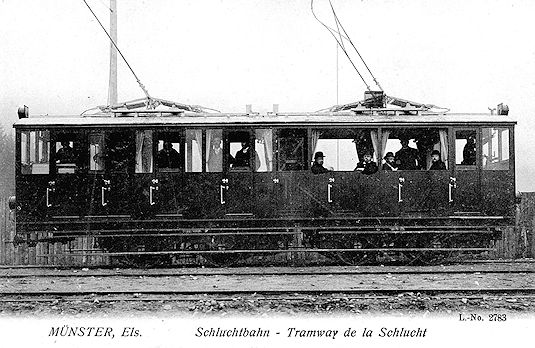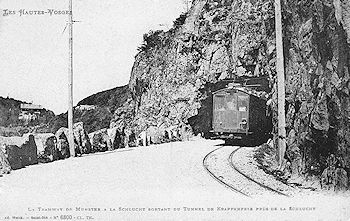

Our main postcard of this Vosges metre gauge tramway is a side view of one of the SLM-Winterthur cars on the Münsterschluchtbahn about 1910. The postcard is by Manias & Cie of Strasbourg. The smaller view below is about 1910 and shows the short tunnel on the upper adhesion section of the Münsterschluchtbahn at Krappenfels close to the La Schlucht terminus, just visible in the distance on the left. The postcard is by Weick of Saint-Dié.
 On 25th May 1905 a concession was awarded to Elektrizität und Bahngesellschaft Münster - Schlucht for construction of the Münsterschluchtbahn (MSchB). This electric tramway opened on 16th May 1907. It ran for 10.8 km but, due to the steep gradients, was rack-assisted for part of the journey. From Munster the tramway passed through Stosswihr, Ampfersbach and Schmelzwasen. Then a Strub rack was used between the edge of Grossmatt and Altenberg. Between Altenberg and the terminus the line ran along the road and included a short tunnel at Krappenfels. At La Schlucht the tramway ended in front of the border customs post, but with no connection to the Gérardmer line on the French side. The upper section was closed in the winter, service continuing on the lower adhesion section according to demand. Power was supplied from a power station at the Munster depot, using two horizontal compound steam engines to generate 7,000 volts AC at 50 Hz three-phase with a substation at Grossmatt, where it was converted into 750 Volts DC. The trams used bow collectors, two on the bogie cars.
On 25th May 1905 a concession was awarded to Elektrizität und Bahngesellschaft Münster - Schlucht for construction of the Münsterschluchtbahn (MSchB). This electric tramway opened on 16th May 1907. It ran for 10.8 km but, due to the steep gradients, was rack-assisted for part of the journey. From Munster the tramway passed through Stosswihr, Ampfersbach and Schmelzwasen. Then a Strub rack was used between the edge of Grossmatt and Altenberg. Between Altenberg and the terminus the line ran along the road and included a short tunnel at Krappenfels. At La Schlucht the tramway ended in front of the border customs post, but with no connection to the Gérardmer line on the French side. The upper section was closed in the winter, service continuing on the lower adhesion section according to demand. Power was supplied from a power station at the Munster depot, using two horizontal compound steam engines to generate 7,000 volts AC at 50 Hz three-phase with a substation at Grossmatt, where it was converted into 750 Volts DC. The trams used bow collectors, two on the bogie cars.
The rolling stock was built in Switzerland by SLM-Winterthur with electrical equipment by Société Suisse Alioth. There were three large rack-fitted bogie cars numbered BP1 to BP3 and a small adhesion-only 4-wheel car numbered B4 which was used on shuttle services between Munster and Grossmatt. There were also three 4-wheel rack fitted trailers and two non-rack trailers, plus three wagons. The motor bogies for the rack section were of an interesting design. Each of the two bogies on the larger cars had two 43 hp motors, axle-hung but on the outside of the axles, not between them. The "downhill" motor drove the cog-wheel, which was loose on the running axle, via double-reduction gearing. The "uphill" adhesion axle was driven by its motor using simple gearing. Although the wheels were equal sized, the kingpin was displaced towards the uphill end of each bogie to provide a maximum-traction effect. They were fitted with conventional wheel brakes, rheostatic braking and a drum brake on the cog-wheel. Large controllers were mounted longitudinally at one side of the driving cab. They had two drums, one with 8 series-only notches and 7 brake notches to control the cog-wheel, the other with 5 series, 4 parallel and 5 brake notches for the adhesion axle.
Services ceased in 1914 and the tramway was damaged during the war, never to be rebuilt. Only its upper part, from the La Schlucht to Altenberg, was briefly used during the war by the French Army, who had made the necessary connection at the former Schlucht border.
REMIREMONT - GÉRARDMER (See Postcard)
Intermediate towns Julienrupt, Le Tholy. A roadside steam light railway operated by Compagnie des Tramways des Vosges.
GÉRARDMER - RETOURNEMER (See Postcard)
Intermediate town Longemer. A roadside steam light railway operated by Société des Tramways de Gérardmer.
RETOURNEMER - LA SCHLUCHT - HOHNECK (See Postcard)
Electric tramway operated with railcars having two bow collectors by Société des Tramways de Gérardmer.. In addition to the through service (which reversed into and out of La Schlucht), the La Schlucht - Hohneck section had a shuttle service ran by two Preston built trams with single bow.
LA SCHLUCHT - MUNSTER (This Page)
Operated as the Münsterschluchtbahn using electric railcars with two bows similar to above, but rack assisted.
TURKHEIM to TROIS ÉPIS (See Postcard)
Electric tramway operated as the Tramway Touristique Turckheim - Trois Épis
![]() Go to Postcard Of The Month Index
Go to Postcard Of The Month Index